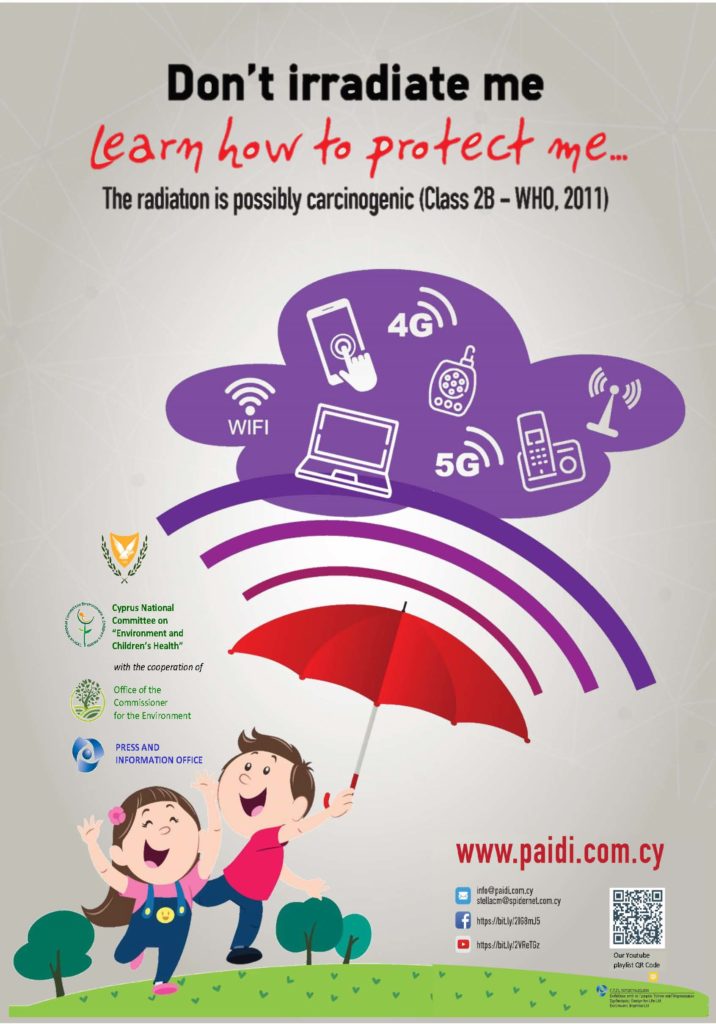Det finns en hel del positiva initiativ inom Europa för att minska den elektromagnetiska strålningen i samhället. Här är ett exempel.

I juni 2019 hölls en presskonferens där Cypern presenterade ”The new wireless public awareness campaign”. Kampanjen ska skapa medvetande hos allmänheten om hur man reducerar exponeringen från trådlös strålning.
Vid presskonferensen presenterades även projektet för att minska barnens strålning inom sjukhuset The Archbishop Makarios sjukhus på Cypern. Sjukhusets VD: ”We are reducing direct and passive exposure of children to non-ionizing radiation. We protect the children.”
Kampanjen till allmänheten och sjukhusprojektet stöds bl.a. av Cyperns hälsominister och Cyperns miljöminister.
Inom sjukhuset inriktas arbetet på att minimera den trådlösa strålningen från mobiler, wifi m.m. på intensivvårdsavdelningen för barn samt på neonatalavdelningen. Projektet är ett samarbete mellan sjukhuset och Cyperns Committee on the Environment and Children’s Health.
Sjukhusprojektet ska bl.a. arbeta med detta.
- Wi-Fi tas bort och ersätts med uppkopplingar med internetkablar på barnintensiven och neonatalavdelningen.
- Föräldrar utbildas i att hålla mobiltelefonerna på avstånd från barnen och utanför barnavdelningarna.
Informationsmaterial och länkar
Här finns information om sjukhusprojektet och även den kampanj som startas inom Cypern för att skapa medvetande hos allmänheten om hur man reducerar exponeringen från trådlös strålning. Projekten stöds bl.a. av Cyperns hälsominister och Cyperns miljöminister.
- Cyprus Children’s Health and Wireless Awareness (En sida) Recommendations Leaflet Engelska
- Cyprus (16 sidor) How to reduce Wireless at Home Engelska
- Press Release on the Archbishop Makarios III Hospital Initiative , June 2019 Engelska
The Cyprus National Committee on Environment and Children’s Health website
Från forskningen (Källa Environmental Health Trust):
EHT Notes: Electromagnetic fields within neonatal incubators have been shown to have adverse effects on newborns. Research has found that equipment in the NICU creates low-frequency electromagnetic fields “that can have subtle yet measurable effects on the autonomic nervous system” and preterm infants are especially vulnerable to these effects. A study that looked at 26 preterm infants from the NICU at Penn State Health Milton S. Hershey Medical Center measured the environmental electromagnetic levels in and around incubators. Then, the researchers electrically grounded the babies to reduce the exposures. They found that the babies autonomic nervous system “is able to sense the electrical environment” and the babies were more relaxed when they were grounded.
In 2017 Bellieni and colleagues carried out a review of the current research on electromagnetic fields in neonatal incubators, and concluded, “…future incubators should be conceived following better criteria about EMF emissions, redesigning the incubator components” (Bellieni et al., 2017). Earlier publications by Bellieni and colleagues report similar findings including changes in melatonin production and altered heart rate variability. Due to the vulnerability of newborn babies, preventative and prudent measured should be taken against exposure to electromagnetic fields.
Based on the current human and animal research on radiofrequency, several scientists have published studies concluding that radiofrequency is a human carcinogen (Hardell and Carlberg 2017, Peleg et al., 2018, Miller et al 2018). When combined with lead or a known carcinogen, RFR has been shown to promote tumor development and enhance toxic effects. For example, a 2015 Jacobs University replication study found more than doubled the numbers of liver and lung tumors in carcinogen-exposed mice when combined with RFR at levels well below FCC limits (Lerchl 2015). A 2017 literature review (Kostoff and Lau. 2017) published in Microwave Effects on DNA and Proteins found there is “substantial credible scientific evidence” supporting not only tumor promotion but also enhanced cellular or genetic mutations, and teratogenicity from nonionizing radiation. FacebookTwitter



